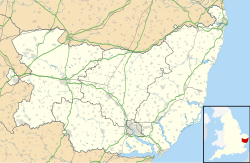| Church of St Peter and St Mary, Stowmarket | |
|---|---|
 The church from Station Road West | |
| 52°11′18″N0°59′47″E / 52.1883°N 0.9964°E | |
| Location | Stowmarket, Suffolk |
| Country | England |
| Denomination | Anglican |
| Website | www |
| History | |
| Dedication | Saint Peter & Saint Mary |
| Architecture | |
| Functional status | Church of England parish church |
| Heritage designation | Grade I |
| Designated | 28 July 1950 |
| Architectural type | Church |
| Style | Decorated Gothic |
| Groundbreaking | 14th century |
| Specifications | |
| Bells | 8 |
The Church of St Peter and St Mary stands in the town of Stowmarket, Suffolk, England. It is an active Church of England parish church in the Diocese of St Edmundsbury and Ipswich. The church dates from the 14th century and is a Grade I listed building.
